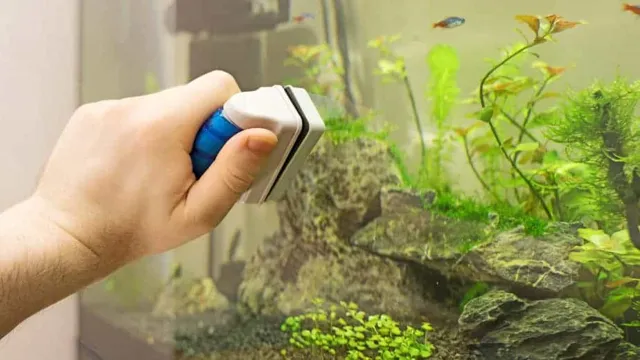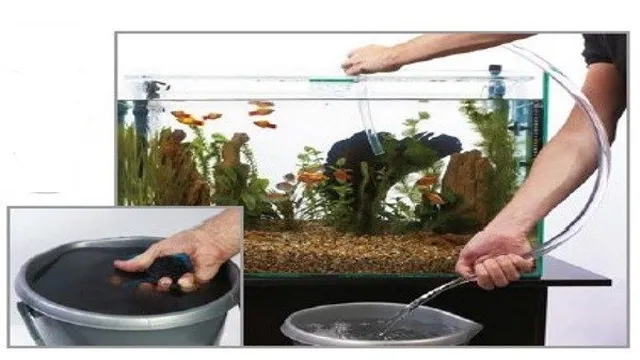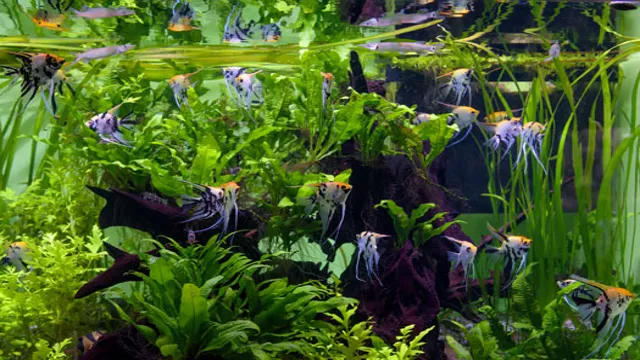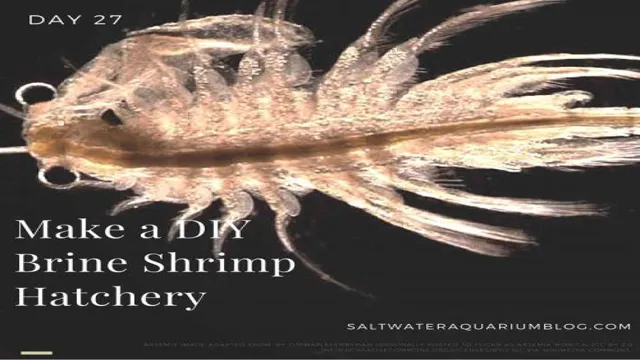Keeping fish is a popular hobby for people of all ages. Who wouldn’t love to have a miniature aquatic world right in their homes? However, with the joy of maintaining fish, there comes the responsibility of diligent care. That means, cleaning and maintaining your fish’s habitat regularly.
But how do you clean fish aquarium water? What products should you use, and what should you avoid? What steps should you take to maintain a clean and healthy environment for your fish to thrive in? In this guide, we’ll explore all the different ways to keep your fish’s water clean, healthy, and crystal clear. Whether you’re a beginner or a seasoned fish keeper, this guide will provide you with everything you need to know about cleaning your fish’s aquarium water. So, let’s dive in!
Understanding Aquarium Water
Are you struggling with how to clean fish aquarium water? Understanding aquarium water is crucial to maintaining a healthy environment for your fish. Fish waste, uneaten food, and plant debris can all contribute to the buildup of harmful chemicals and toxins in the water. Regular water changes, using a gravel vacuum to remove debris from the substrate, and testing the water regularly for pH, ammonia, nitrite, and nitrate levels are all essential steps to keep your aquarium water clean.
Additionally, adding live plants and investing in a high-quality filtration system can help keep the water clear and free of harmful pollutants. Remember, taking care of your aquarium water is a key factor in ensuring the health and happiness of your fish.
Testing the Water
Aquarium Water If you’re new to the world of aquariums, it can be overwhelming to understand why water quality is so important. Aquarium water is much more than just H2O; it’s a complex mixture of dissolved gases, minerals, and organic matter that can significantly impact the health of your fish and other aquatic life. Testing the water regularly is essential to ensure that the conditions inside your tank are suitable for your pets to thrive.
Testing kits are widely available at pet stores and come with instructions on how to measure things like pH, nitrate, and ammonia levels. Once you get the hang of it, testing the water doesn’t take more than a few minutes, and it can save you a lot of headaches and money in the long run. Think of it like checking the oil in your car; even if everything seems fine on the surface, internal problems can quickly snowball without proper maintenance.
In the same way, understanding and monitoring aquarium water is crucial for the health of your pets and the overall success of your aquarium.

Identifying Common Water Problems
Aquarium water is a complex system that requires careful attention in order to maintain the health of your fish and other aquatic creatures. There are several common water problems that aquarium owners may encounter, including pH imbalances, high ammonia or nitrate levels, and algae growth. Understanding the chemistry of your aquarium water is an essential part of keeping your aquatic ecosystem in balance.
For example, pH levels that are too high or too low can stress your fish, causing health problems and even death. Additionally, high levels of ammonia and nitrate can be toxic to fish, leading to poor water quality and unhealthy conditions. One important step in understanding your aquarium water is to test it regularly using a reliable testing kit.
This will allow you to monitor any changes in water quality and take action to correct any issues. By understanding the complex ecosystem of your aquarium and taking proactive steps to maintain its balance, you can create a healthy environment for your aquatic pets to thrive.
Regular Maintenance
Keeping your fish tank water clean is an important part of regular maintenance to ensure your fish are healthy and happy. Start by removing any debris, uneaten food and waste from the tank weekly using a siphon or gravel vacuum. You should also clean the tank’s decor and surfaces using a soft brush to avoid scratching or harming the fish.
Keep in mind that completely replacing all the water at once can cause undue stress on your fish, so instead, aim to replace around 25% of the water every two to four weeks. Make sure to add a water conditioner to the new water to neutralize chlorine and other harmful chemicals. If you’re having difficulty maintaining your water quality, consider testing the water regularly and using a filter to help remove excess waste and chemicals. (See Also: How to Get to Sea Aquarium from Vivo: Expert Tips and Tricks)
With the right care, you can enjoy a beautiful and thriving aquarium for years to come!
Changing the Water
Regular maintenance is crucial for keeping your aquarium healthy and your fish happy. One important task is changing the water. It is essential to remove old water and replace it with fresh water on a regular basis.
One way to determine how often to change the water is to monitor the ammonia and nitrate levels, which can spike quickly and harm your fish. Generally, changing 10-15% of the water every week is recommended. When changing the water, make sure to siphon the gravel at the bottom of the tank to remove any debris or waste that has accumulated.
Additionally, it’s important to add a water conditioner to remove chlorine and chloramine from tap water before adding it to the tank. Remember to let your new water sit for a while to adjust to room temperature before adding it to the aquarium. Keep your fish healthy and happy by implementing a regular water changing schedule.
Cleaning the Gravel
Regular maintenance is important when it comes to keeping your fish aquarium clean and healthy. One crucial aspect of maintaining your aquarium is to regularly clean the gravel. Gravel collects fish waste, excess food, and other debris, which can make your aquarium environment unhealthy if left unattended.
To start the cleaning process, remove any large debris with a siphon or net. Then, use a gravel vacuum to remove smaller debris and excess food. It’s essential to avoid removing all the gravel with the vacuum, as beneficial bacteria grow on the surface.
A general rule of thumb is to clean only a quarter of the gravel bed each time, to prevent disturbance to the bacteria colony. As you’re cleaning the gravel, take note of any unusual discoloration, which could indicate potential issues with the water quality. Regular cleaning of the gravel can help keep your aquarium water clear and healthy.
Maintaining the Filter
Regular maintenance is essential for the proper functioning of your filter. Just like any other machine, the filter requires proper care and attention to work efficiently. Regular cleaning will ensure that your filter works optimally and provides clear and clean water for your aquarium.
A dirty filter not only affects the quality of water but also the health of your fishes and aquatic plants. So, make sure you clean your filter regularly. To do so, remove the filter and clean it thoroughly with a brush.
Be sure to replace any parts that are worn out or damaged. By performing regular maintenance, you can extend the life of your filter and keep your aquarium healthy and beautiful. So, make sure to set a regular schedule for filter maintenance to avoid any unexpected issues and maintain the health of your aquatic life.
Advanced Cleaning Techniques
If you own a fish aquarium, you know how important it is to keep the water clean and healthy. One of the best ways to accomplish this is through regular water changes. However, there may be times when you need to go a step further and use advanced cleaning techniques to clear up any problems with the aquarium water.
One effective method is the use of activated carbon, which can help eliminate foul odors and discoloration in the water. Another technique that can be helpful is using a gravel vacuum to remove debris from the bottom of the tank. Additionally, there are various chemicals available on the market that can be used to treat different water issues, such as treating algae or eliminating harmful bacteria. (See Also: How to Build an Overflow Box for Aquarium: A Step-by-Step Guide for Beginners)
As always, it is important to research and follow any instructions carefully when using such products to ensure the health and safety of your aquarium inhabitants. By utilizing these advanced cleaning techniques, you can help keep your fish aquarium water clear and healthy for your aquatic pets.
Using Water Conditioners
If you’re serious about keeping a clean and healthy aquarium, you might want to consider using water conditioners. These products work by removing harmful chemicals and impurities from your aquarium water, making it safe and healthy for your aquatic pets. Advanced cleaning techniques like this can really make a difference in the overall health and happiness of your fish.
Plus, they can help prevent common aquarium problems like cloudy water, algae growth, and fish illness. Using water conditioners is easy and affordable, and can help you create a beautiful and thriving aquatic environment for your pets. So why not give them a try today? Your fish will thank you!
Adding Beneficial Bacteria
When it comes to advanced cleaning techniques, adding beneficial bacteria to your cleaning routine can have some amazing benefits. Beneficial bacteria, also known as probiotics, help to create a healthy and balanced environment in your home by consuming harmful bacteria that may cause illness or odors. They work by breaking down organic matter and converting it into a form that is easily consumed by other beneficial bacteria.
This creates a self-sustaining ecosystem that can help to keep your home clean and healthy. To incorporate beneficial bacteria into your cleaning routine, look for products that contain probiotics and use them regularly. You can also find natural sources of probiotics such as yogurt or kefir and use these to clean surfaces like countertops or floors.
By adding beneficial bacteria to your cleaning routine, you can create a healthier and happier home for you and your family.
Preventing Future Problems
Keeping your fish tank clean is essential for the health and well-being of your aquatic pets. High levels of ammonia and nitrite in the water can cause significant problems, such as fin rot and other bacterial infections, for the fish. Moreover, it can lead to an unpleasant smell and an unappealing appearance of your tank.
One of the easiest ways to prevent these issues is to perform regular water changes. Changing out 10-20% of the water weekly will remove any excess waste and pollutants that have accumulated in the tank. Additionally, investing in a good quality filter will help to keep the water clean and clear.
When you clean your filter, try not to wash it with soapy water as this can kill the beneficial bacteria that live inside. Instead, wash it with some of the old tank water that you remove during the water change. Lastly, maintaining a consistent feeding schedule and not overfeeding your fish will also decrease the amount of waste present in the tank, contributing to its cleanliness.
By following these simple steps, you can help ensure a healthy, happy, and clean environment for your aquatic companions. And if you are thinking about how to clean fish aquarium water without any hassle, these solutions can help you achieve that.
Conclusion
In conclusion, keeping a fish aquarium clean is crucial to the health and well-being of your aquatic critters. With these simple steps, cleaning your fish tank will no longer feel like a daunting task. Remember to test your water, perform regular water changes, and keep up with filter maintenance. (See Also: How to Increase Oxygen Content in Aquarium and Boost Your Fish’s Health)
By following these tips, you’ll be able to create a clean and happy home for your finned friends. Your fish will thank you, and who knows, they may even start doing the dishes too!”
FAQs
Why is it important to clean the water in a fish aquarium?
Regular cleaning of aquarium water is important because it helps to remove harmful toxins and bacteria that can harm fish and other aquatic creatures in the tank. If the water is not cleaned regularly, it can become murky and polluted, which can affect the health of the fish and lead to diseases that can be fatal.
How often should you clean your fish tank water?
The frequency of cleaning your fish tank water depends on the size of your aquarium, the number of fish you have and how often you feed them. In general, it is recommended to do a partial water change every 1-2 weeks, depending on the circumstances.
What is the process of cleaning fish aquarium water?
The process of cleaning fish aquarium water involves removing a percentage of the water from the tank, vacuuming the substrate, cleaning any decorations or equipment, and replacing the water that has been removed with fresh, clean water that has been conditioned with a dechlorinator.
Can you use tap water to fill a fish tank after cleaning?
Yes, you can use tap water to fill your fish tank after cleaning, but it is essential to treat it with a dechlorinator first. Chlorine and other chemicals present in tap water can be harmful to fish and other aquatic creatures.
What are the signs that the water in the aquarium needs to be cleaned?
Signs that the water in the aquarium may need to be cleaned include discolored or murky water, bad odor, visible debris or waste on the substrate or around the tank, stressed or sick fish, and an overall decline in the health of the aquarium.
Can you overclean a fish tank?
Yes, it is possible to overclean a fish tank. Cleaning too frequently or changing too much water at once can disturb the balance of beneficial bacteria in the tank, which can lead to ammonia and nitrite spikes, causing stress and illness in fish.
What should you do with fish during the cleaning process?
It is essential to keep the fish in the tank while cleaning the water, but you should take care not to disturb or stress them unnecessarily. You can move them to a separate container with some of the tank’s water during the cleaning process, but it’s important to handle them gently and not keep them out of the water for too long.







